(Warning: long posting with lots of graphs!)
Much time was expended on social media in the recent County Council election in East Cambridgeshire debating (if that’s the right word) the merits or otherwise of a ‘progressive alliance’ of non-Conservative and non-UKIP parties. The idea was that the various parties should stand down in each other’s favour and unify around a single candidate in each seat, thus ensuring the defeat of the Conservatives.
There is much that could be (and has been) said about the principle behind this argument. Labour supporters have said there is nothing ‘progressive’ about a Liberal Democrat party that formed a government with the Conservatives in 2010-2015. Liberal Democrats have retorted there is nothing ‘progressive’ about a Labour party that has backed Conservative plans for a ‘hard Brexit’. It can be argued that the political climate in the UK has moved on since last year’s EU referendum, with the traditional left-right model increasingly fractured, and newer interests beginning to coalesce (Labour’s Kate Hoey in that boat with Nigel Farage being just one memorable example).
This posting does not intend to rehash these arguments or consider whether they are right or wrong, but rather to examine Thursday’s actual results in East Cambridgeshire to see whether, in practical terms, a ‘progressive alliance’ approach would actually work in practice. For this purpose, it takes at face value the notion that Liberal Democrat, Labour, and Green parties are ‘progressive’ with a shared set of core values; that they would be able to unite and marshal all their respective voters behind candidates of another party; and that denying voters the chance to vote for a candidate of their choice in the cause of the ‘greater good’ is a good thing. (Those are pretty big assumptions, which I do not necessarily accept, and merely take on board for the purpose of what follows).
In order for a ‘progressive alliance’ to succeed in a particular seat, this posting assumes two basic criteria:
- That the aggregated votes of Liberal Democrat, Labour and Green candidates total more than the votes of the Conservative candidate in that seat; and
- That one of those three parties can evidence a lead over the others sufficient to demonstrate that it has not only the ‘right’ or mandate, but also the credibility and supporting infrastructure to win the seat.
It is clear that in East Cambridgeshire a number of seats can be discounted on this basis, as they do not meet the criteria.
(Note: all bars drawn to scale).
In Littleport and Soham North & Isleham, neither criterion is met. The winning Conservative candidate secured comfortably more than 50 per cent of the total vote, and in each case only 25 votes separated the Liberal Democrat and Labour candidate – the two seats being a mirror image of each other in this respect, with Labour nosing ahead in one seat and Liberal Democrats in the other.
In Burwell, Soham South & Haddenham, and Woodditton, the three ‘progressive’ parties were not able to marshal sufficient votes between them to exceed the Conservative vote. One of those parties is however capable of evidencing a clear lead over the others in these seats – and in all three cases it is the Liberal Democrats.
That leaves three seats in East Cambridgeshire which meet both criteria – a total vote among the three ‘progressive’ parties that is greater than the Conservative vote, and a clear ‘front-runner’.
In Sutton division, the sitting Liberal Democrat councillor (raises hand) was returned with a slender majority of 88 over the Conservative challenger. In this seat, the ‘progressive alliance’ had encouraged people to vote Labour, risking handing an additional seat to the Conservatives. The actual result shows firstly how misguided and risky (from a ‘progressive’ viewpoint) this strategy was, but secondly that voters were wiser than those advising them, and refused to be taken in by such blandishments. Sadly, and shockingly for democracy, this remains the only non-Conservative county council seat in East Cambridgeshire.
In Ely North and Ely South, however, enough voters (encouraged by the ‘progressive alliance’) chose the third-placed party to help the Conservatives hang on.
The unifying factor in all the above seats (apart from Littleport and Soham North & Isleham where no ‘progressive’ party could win) is that it is the Liberal Democrats who are clearly the challengers to the Conservatives. There is literally no seat in East Cambridgeshire which Labour or the Greens could win, even if the parties standing down managed to corral every single one of their voters into the polling station to vote for a party that was not their first choice. Labour has not won a county council seat in East Cambridgeshire since 1993 – not even in 1997, the year in which Tony Blair swept victorious into Downing Street carrying all before him.
This self-evidently means that demands for ‘horse-trading’ between the ‘progressive’ parties in East Cambridgeshire are futile, as two of the three parties have nothing to trade. However, a unilateral decision by Labour to stand down in the Liberal Democrats’ favour in Ely North and Ely South might have made the difference. (It could perhaps have been reciprocated somewhere else in the region).
Next month ballot-weary voters will return to the polls yet again for a General Election to elect their MP, some three years earlier than expected. The concept of a ‘progressive alliance’ in South East Cambridgeshire for that election has been mooted. In that context, the total number of votes cast for each party across the South East Cambridgeshire constituency* in Thursday’s local elections makes for instructive reading.
Which party clearly has the strength and the support to take on the sitting Conservative Lucy Frazer?
(*Note that South East Cambridgeshire constituency does not include Littleport or Sutton, but does include a number of seats in South Cambridgeshire district – hence the number of votes in the constituency graph is not an aggregate of the votes in the East Cambridgeshire districts).
Finally, the parallel election which took place on Thursday, for the Mayor of Cambridgeshire & Peterborough, has some instructive insights to offer into the practicality of a ‘progressive alliance’ approach. In this election voters could exercise a first, but also a second, choice – giving a glimpse of their willingness or otherwise to switch parties, even after having been able to use their first vote for their first choice of candidate.
What was noticeable during the campaign was the willingness of Labour voters to give their second vote to the Greens, or to the Conservatives, or to the independent candidate, or even to UKIP. Green voters were happy to give their second vote to Labour, or the Conservatives, or the independent or UKIP or even the English Democrats. Only a minority of Labour and Green voters were prepared to give their second vote to the Liberal Democrat candidate, even when – as was eventually proved at the election count on Friday – he was evidently the clear challenger to the Conservative throughout the contest.
And if the Labour and Green parties cannot ensure that their voters will give a second preference vote to the Liberal Democrats even after they have had the luxury of using their first preference vote for their preferred candidate, how can they guarantee that a ‘progressive alliance’ will deliver its stated aim of defeating the Conservatives and ensuring a more balanced and democratic county council?
No-one would be happier than I if there were a ‘quick fix’ way to mend East Cambridgeshire’s broken politics – being the leader of a group of two on the district council facing the serried ranks of 36 Conservatives at council meetings is a constant reminder of that. Ultimately what is needed is electoral reform to introduce a proportional voting system on local councils, to better reflect the views and wishes of their residents.
In the meantime, however, misleading claims that votes for third or fourth placed parties can unseat powerful Conservative interests only serve to make the democratic deficit wider than ever.

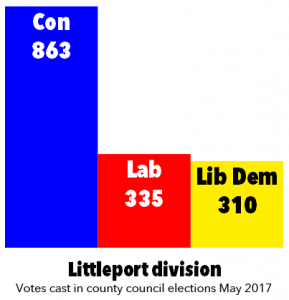
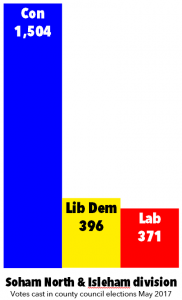
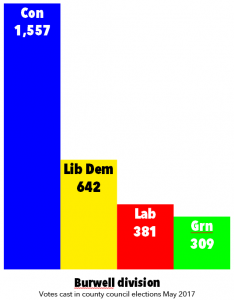
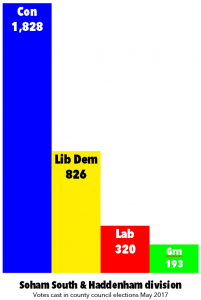
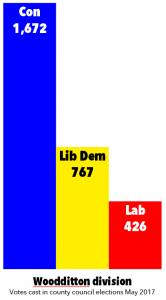
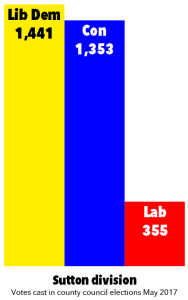
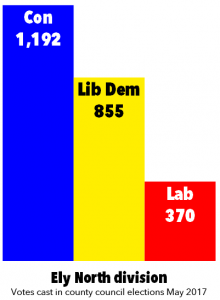
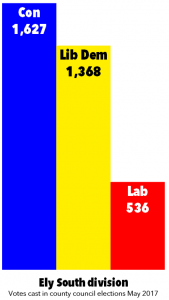
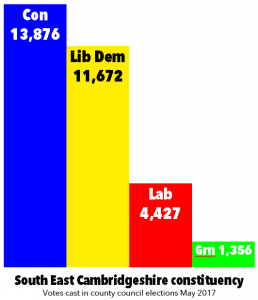
Your 2nd point leads to supporting LibDem candidates as the anti-tory tactical vote. That’s not a progressive alliance that’s just “only the LibDems can beat the Tories here”. It’s also quite a negative approach.
I would suggest that it should say that the aim is to elect candidates in proportion to the support their party has. The figures then lead to supporting mostly LibDems but not ALL LibDems. That’s an alliance and it’s a much more positive stance.
Hi, Andy. I absolutely agree with your fundamental point that we ought to see candidates elected in proportion to the popular support for their party. That’s why I support a change to a more representative voting system.
However, trying to impatiently force a ‘bodge’ on people in the meantime not only doesn’t work, it’s totally and dangerously counter-productive (see Ely North and South). The *evidence* of Thursday in East Cambridgeshire (and I’ve provided the figures in my blog post) shows that there is no electoral area in the district in which anyone other the Liberal Democrats has sufficient support to win a seat from the Conservatives, even if all the other non-Conservative parties stood down. Wishing it were different doesn’t make it so.
I could envisage some kind of arrangement across a wider area – supporting Lib Dems in Ely in exchange for supporting Greens in a couple of seats in Norfolk or Suffolk, for example. But pretending that one can just carve up East Cambridgeshire between parties who aren’t going to win doesn’t get anyone anywhere. And deliberately seeking to replace sitting Liberal Democrat councillors with Conservatives, or throwing spanners in the works of campaigns by Liberal Democrats who are very close to unseating Conservatives, is absolutely my definition of negative.